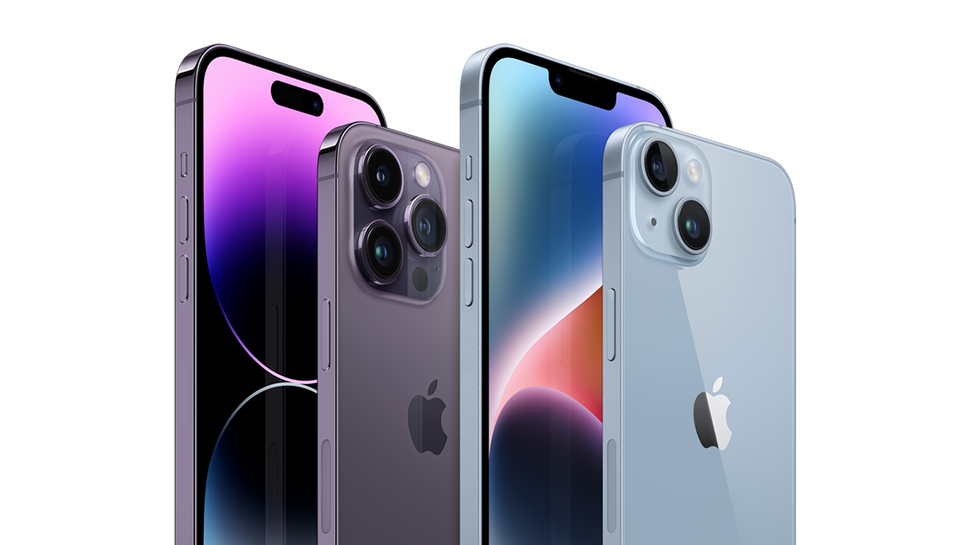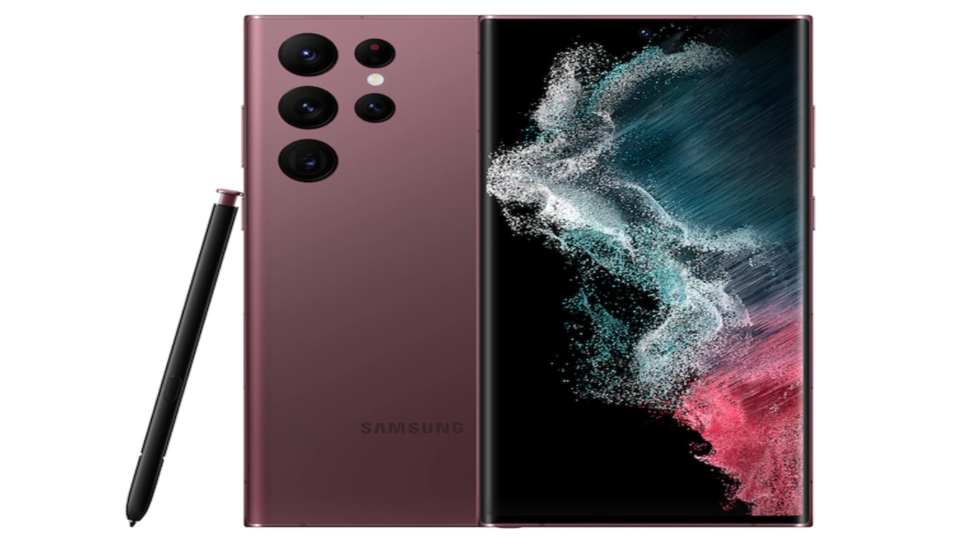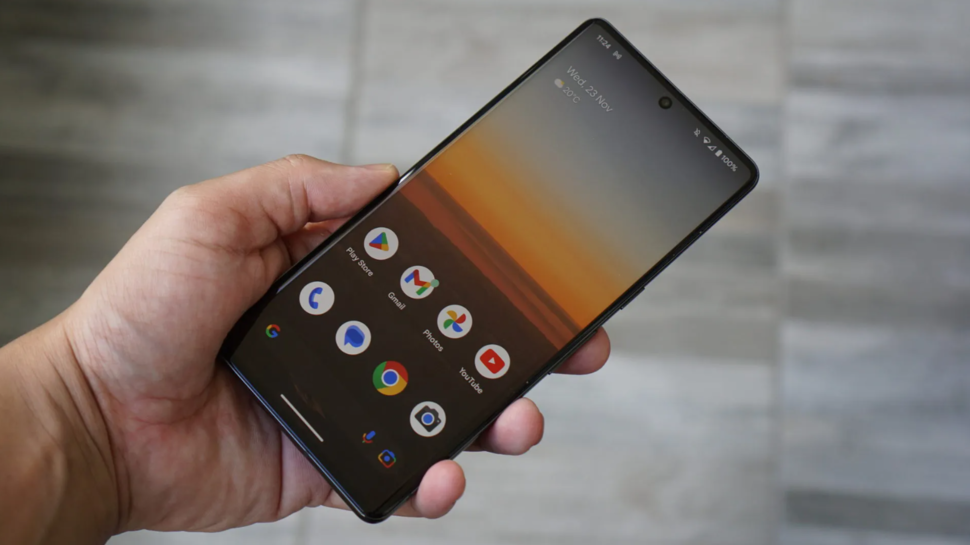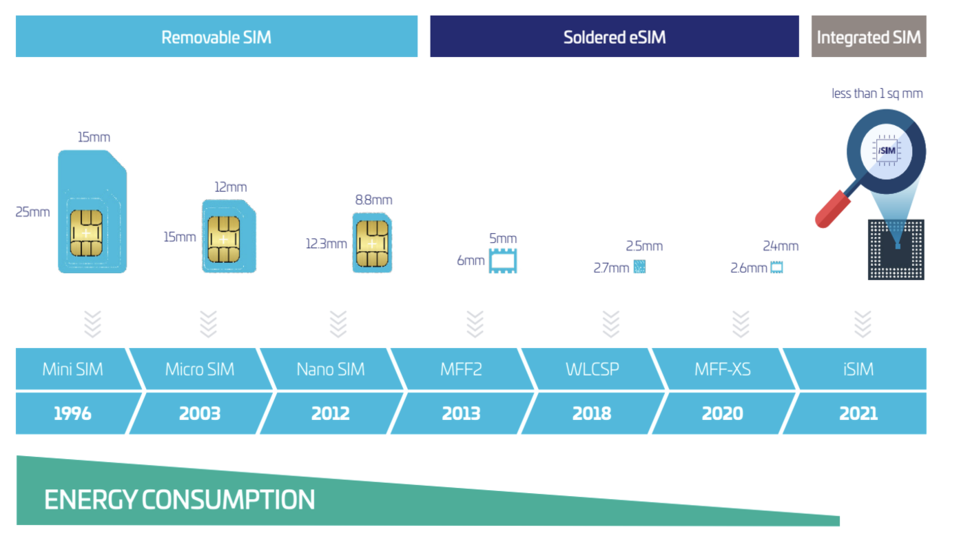
Many smartphones currently support eSIMs, and the number keeps growing over time. The number of eSIM-connected smartphones surged from 144 million in 2022 to nearly 600 million in 2024. If this exponential growth continues, most smartphones will become eSIM-compatible within a decade or two.
So, what’s an eSIM, and why do you need one? What are its advantages over conventional SIM cards, and which smartphones support them? This guide will answer these questions
What is an eSIM anyway?
An eSIM, or embedded SIM, is a SIM card built into a smartphone. It can store multiple SIM profiles and be reprogrammed at any time. It relies on a chip embedded in your smartphone that can be reprogrammed to delete or add new network profiles.
Like conventional SIMs, it can make calls, surf the web, and send texts. However, unlike conventional SIMs, there’s no need to swap any physical material to switch mobile networks.
Think of it like the NFC chip you use for contactless payments, which works with whatever bank you bank with. An eSIM is the same, but it's designed for connecting you to your phone network.
History of eSIM development
eSIM technology was developed by the GSM Association (GSMA) in 2012. GSMA is a non-profit organization representing the interests and initiatives of over 750 mobile network operators globally. The organization began discussing the possibility of a software-based SIM in 2010 and developed a working concept two years later.
The eSIM proposed by GSMA used software embedded in a universal integrated circuit card (UICC) chip attached to a smartphone. The main issue was that UICC chips were primarily used in industrial devices before the 2010s and were hardly found in consumer devices. GSMA developed a separate UICC standard for consumer devices to work around this issue, leaving the other for industrial (machine-to-machine) devices intact.
GSMA published the first standard of its UICC chip for consumer devices in March 2016 and another in November 2016. That same year, Samsung unveiled the Gear S2 smartwatch, the first device to sport an eSIM.
Qualcomm, a well-known mobile chip manufacturer, demoed the first eSIM for a smartphone in 2017. That same year, Apple unveiled a smartwatch with an eSIM and followed with eSIM-compatible iPhones a year later. Apple is one of Qualcomm’s biggest customers, so it’s no surprise that it was the first company to implement the mobile eSIM that its client developed.
All American iPhones released since 2017 have eSIM slots. Non-American versions come with a slot for both eSIM and physical SIM cards because most people across the globe are still used to physical SIM cards. iPhones sold in China don’t use eSIMs because the major telecom providers in the country don’t support them.
Google unveiled Pixel 2, the first Android smartphone supporting eSIM, in October 2017. Subsequent Pixel smartphones come with eSIM, even as Google switched some phones to Samsung chips instead of Qualcomm’s.
Samsung unveiled the S20 smartphone in March 2020 and S21 in January 2021. Both phones had eSIM slots but no software support out of the box. The support came later with an operating system update in November 2021. Since then, most new Samsung smartphones come with eSIM slots.
Many other Android smartphone makers have followed suit with eSIM support. Some phones have ditched physical SIM cards entirely and support only eSIMs, e.g., Motorola Razr.
eSIMs have seen good adoption across the globe. Mobile carriers in over 190 countries now support it. According to Statista, over 350 million devices (smartphones and other gadgets) were compatible with eSIMs in 2021. That figure is expected to rise rapidly to 14 billion by 2030. The same source values the global eSIM market at $4.7 billion as of 2023 and expects the value to rise to $16.3 billion by 2027.
Yet, the rapid growth isn’t balanced worldwide. eSIM adoption is growing more in North America and Europe than other continents. Smartphones that support eSIMs are usually expensive, which puts them out of the reach of the masses in countries with lower incomes than their Western counterparts. Nonetheless, the growth remains impressive for a technology released less than a decade ago.
As with all technological things, progress starts gradually before exploding. eSIMs are mostly present in premium smartphones because of manufacturing costs. However, these costs will come down in time, and you can expect mid-range and low-budget smartphones to start having eSIMs over the next decade. It’s a matter of time before most people start switching to eSIMs, and physical SIM cards become a thing of the past.
eSIMs come with many advantages, which we’ll explain below. It also has disadvantages, which we’ll also touch on. However, the benefits outweigh the disadvantages by a large margin.
What networks support eSIMs?
Most mainstream mobile networks support eSIMs. These range from AT&T, T-Mobile, and Verizon in the U.S.A. to Vodafone in the U.K. and Telstra in Australia. eSIMs are the future, so most telecom carriers support it to avoid falling behind competitors.
In addition to local providers, some worldwide providers also support eSIM. You'll want to look at Truphone, Ubigi, GigSky, eSIM.net, MTX Connect, Readtea Mobile and Soracom mobile.
What are the benefits of eSIMs?
eSIM-only phones are essentially sold unlocked: you simply get the appropriate network settings from an app or via a QR code to program the eSIM and away you go.
eSIMs enable users to switch mobile networks without physically swapping SIM cards. They remove the need to keep small physical SIMs that owners can easily lose. When you visit a foreign country, you can switch to a domestic carrier without swapping an original SIM.
They take up a fraction of the space a traditional SIM card does, even a nano-SIM. The SIM card slot is a pretty hefty bit of hardware, and doing away with it on an eSIM-only device makes life easier for smartwatch, fitness tracker and phone manufacturers. That's especially true for those wanting to make folding, flexible or oddly-shaped devices.
eSIMs are embedded, making them less likely to be tampered with. If your smartphone gets stolen, you can quickly track it with “find my phone” apps because the culprit can’t easily disable your network by removing a physical SIM card.
With eSIMs, you can potentially pick and choose who you want your phone to connect to for different things. For example, you might have one line for calls and a different one for data because network A is great for voice but network B has better 5G speeds, or because you’re in another country and the local network is cheaper for data than your usual provider.
That’s not the only big benefit for holidaymakers and business travelers. If your phone has an eSIM you don’t need to physically swap SIM cards when you travel – and you won’t necessarily need to change your number when you swap networks either. Because your eSIM can store multiple network details and logins, that means you can simply change your eSIM when you arrive in a different country and start using the appropriate network immediately.
Is eSIM an industry standard?
Yes, eSIM technology is standardized by the GSM Association (GSMA). This standardization makes it easy for smartphone manufacturers to add eSIM slots and for mobile carriers to build compatible software.
eSIM is the only globally-backed remote SIM specification, so you don’t need to worry about a VHS/Betamax situation where there are competing and incompatible standards.
Which Smartphones support eSIM?
A lot of new smartphones support eSIMs, usually premium models.
iPhone

Every iPhone released since 2018 supports eSIM, including:
- iPhone XR
- iPhone XS
- iPhone XS Max
- iPhone 11
- iPhone 11 Pro
- iPhone SE 2 (2020)
- iPhone 12
- iPhone 12 Mini
- iPhone 12 Pro
- iPhone 12 Pro Max
- iPhone 13
- iPhone 13 Mini
- iPhone 13 Pro
- iPhone 13 Pro Max
- iPhone SE 3 (2022)
- iPhone 14
- iPhone 14 Plus
- iPhone 14 Pro
- iPhone 14 Pro Max
The iPhone 13 and 14 allow you to have two eSIMs simultaneously. The American versions of the iPhone 14, iPhone 14 Plus, iPhone 14 Pro, and iPhone 14 Pro Max have ditched physical SIM cards altogether. Meanwhile, some Chinese versions don’t support eSIMs.
Newer iPads released since 2019 also support eSIMs, including the iPad Air, iPad Pro, and iPad Mini.
Samsung

Samsung Galaxy smartphones support eSIM, including:
- Samsung Galaxy A54 5G
- Samsung Galaxy S20
- Samsung Galaxy S20+
- Samsung Galaxy S20+ 5g
- Samsung Galaxy S20 Ultra
- Samsung Galaxy S20 Ultra 5G
- Samsung Galaxy S21
- Samsung Galaxy S21+ 5G
- Samsung Galaxy S21+ Ultra 5G
- Samsung Galaxy S22
- Samsung Galaxy S22+
- Samsung Galaxy S22 Ultra
- Samsung Galaxy Note 20
- Samsung Galaxy Note 20 Ultra 5G
- Samsung Galaxy Fold
- Samsung Galaxy Z Fold2 5G
- Samsung Galaxy Z Fold3 5G
- Samsung Galaxy Z Fold4
- Samsung Galaxy Z Flip
- Samsung Galaxy Z Flip3 5G
- Samsung Galaxy Z Flip4
- Samsung Galaxy S23
- Samsung Galaxy S23+
- Samsung Galaxy S23 Ultra
The American versions of the Galaxy Z Flip, Galaxy Z Fold 2, S20/S21, S20 FE, and Note 20 Ultra are incompatible with eSIMs.
Pixel

Google’s Pixel phones use eSIMs, including:
- Google Pixel 2
- Google Pixel 2 XL
- Google Pixel 3
- Google Pixel 3 XL
- Google Pixel 3a
- Google Pixel 3a XL
- Google Pixel 4
- Google Pixel 4a
- Google Pixel 4 XL
- Google Pixel 5
- Google Pixel 5a
- Google Pixel 6
- Google pixel 6a
- Google Pixel 6 Pro
- Google Pixel 7
- Google Pixel 7 Pro
- Google Pixel Fold
Premium smartphones from many other brands support eSIMs, including Oppo, Huawei, Xiaomi, Motorola, etc.
How to activate an eSIM
The QR code is critical for activating an embedded SIM on your smartphone. Follow these steps:
1. Head to Settings > Cellular.
2. Tap Add Cellular Plan.
3. Use your smartphone to scan the QR code provided by your carrier. You may be prompted to enter an activation code, so do that and activate your eSIM.
Alternatively, you can use a mobile carrier app.
i) Go to the App Store or Play Store on your mobile device while connected to a Wi-Fi network.
ii) Search for and download your carrier’s app.
iii) Use the carrier app to buy a cellular plan. You can pay using Apple Pay on App Store or Google Pay on the Play Store.
iv) After paying, activate the plan from your Settings app.
Can my phone have both eSIM and SIM cards?
Yes, a phone can have both an eSIM and a removable SIM card. This allows the owner to have two separate numbers on one smartphone, e.g., one for personal use and another for work. Many premium smartphones have ports for both eSIMs and physical SIMs.
Does an eSIM improve my security?
Yes, using an eSIM brings about various security benefits. Nobody can steal an embedded SIM without stealing the phone entirely, whereas someone can steal a physical SIM and leave the phone intact. Stolen physical SIMs are often used to identify swap scams to gain access to sensitive data. Using an eSIM reduces the risks of this happening.
What should I do to my eSIM when upgrading or replacing a phone?
When it's time to upgrade or replace your phone, confirm if it has an eSIM, physical SIM, or both. If it uses an eSIM, ensure you wipe all the data from the eSIM card before disposing or trading it. If not, another person that gets their hands on the phone can access the sensitive data. You can check with your smartphone manufacturer and mobile carrier for instructions on wiping the data.
If your phone has a physical SIM, remove it and store it securely or destroy it if you have no use for the SIM card. This also prevents another person from accessing your sensitive data.
Do eSIMS incur roaming charges?
Roaming charges are extra fees a user pays when connecting to a foreign network while abroad. Data roaming allows people to access network coverage outside their home country, but it usually comes with extra fees.
eSIMs let you enjoy data roaming without swapping SIM cards in another country. Some telecom providers do not charge eSIM users for data roaming, meaning you can surf the internet in foreign countries for the same price. However, you may still face extra fees for calls and SMS messages.
Do eSIMs cost more than physical SIM cards?
eSIMs are cheaper than SIM cards because you don’t have to pay for a physical card. It works primarily with software, so the carrier only needs to reconfigure the eSIM (with your permission) so that you can connect to its mobile network.
Frequent travelers can save significant money by using eSIMs. You don’t have to pay for a physical card every time you visit a new country and dispose of it when you’re done. It even reduces plastic waste to help the environment.
How do I check if my phone is eSIM compatible?
iPhone
The first thing to do is confirm if your iPhone is carrier-unlocked.
- Head to Settings > General > About
- Scroll down to Carrier Lock
- If you see “No SIM restrictions,” your phone is carrier-unlocked
Follow these instructions to check if it’s eSIM-compatible;
- Head to Settings > Cellular. You will see the list of active SIM cards at this point.
- Tap “Add mobile data plan.” If you see a QR code scanning option, your iPhone supports eSIMs. If not, it is incompatible with embedded SIMs.
Samsung
Head to Settings> Connections> SIM card manager. If you see an "Add eSIM" option, your Samsung phone is compatible.
Alternatively, tap "IMEI" in your settings' search bar, and an option for "IMEI information" will appear. If you can find “IMEI (eSIM),” your smartphone is compatible.
Google Pixel
- Go to Settings > Networks and Internet.
- Look for the “Advanced” option and select it.
- Click Add Operator. If you receive a prompt to use your phone's camera to scan a QR code, it is compatible.
Huawei
- Go to Settings > Mobile Networks > SIM Management.
- In the SIM Management submenu, you should see an option to add SIM or eSIM. If you see the latter, your device is compatible.
Motorola
- Head to Settings, Internet & Networks, Mobile Network.
- Go to Advanced > Carrier.
- Tap Add Carrier.
- A screen to scan a QR code will appear, confirming that your smartphone is eSIM-compatible.
Oppo
- Dial *#06# on the touchpad and press call. If your device supports eSIMs, you should be able to view your eSIM identification number (EID) after dialing this number.
- You can also head to Settings > About > Status info. You'll find the unique eSIM identification number (EID) under Status info. If you can’t find the EID, your device is incompatible with eSIMs.
The process for checking compatibility is similar for most phones. It involves going to your network settings and selecting the option for managing your cellular connection. If your phone’s manufacturer isn’t mentioned above, don’t fret. Just follow something similar to the above instructions to check if your device is compatible with eSIMs.
iSIM: The next iteration
iSIM stands for Integrated SIM. It is the next generation of SIM technology that the world will likely see. It remains a concept but is a good hint of what’s to come.
The idea for an iSIM is to remove the subscriber identity module from a separate chip. The SIM will, instead, be positioned within the smartphone’s central processing unit. It will be protected by a tamper-resistant element (TRE) in this conceptual position. It works precisely like eSIMs but with the chip built into the smartphone’s main processor instead of a separate area.
The conceptual iSIM will be up to 98% smaller than an eSIM, freeing even more space for smartphone manufacturers to add hardware materials. It will be cheaper because it uses fewer hardware components, and it will reduce power usage in smartphones.

Qualcomm announced the iSIM at the 2023 Mobile World Congress (MWC) conference in Barcelona, Spain. The company unveiled a SIM embedded within a smartphone chip it sells, giving the public a peek into the next generation of SIM technology.
Another expected benefit of an iSIM is increased security. The customer ID and details about network connections are embedded into the main processor, so it’s more difficult for anyone to tamper with the SIM to get unauthorized access to sensitive information. Just like an eSIM, an iSIM will be able to connect to multiple mobile carriers and give users more flexibility.
iSIMs will make things better not just for smartphones but also for Internet-Of-Things (IoT) device manufacturers, e.g., smart speakers. These manufacturers can embed iSIMs in their devices to make connecting to 5G networks easy. iSIMs free up space, which IoT manufacturers can utilize to add more battery power.
It is more cost-effective for the manufacturers to design a single chip that handles all the device functions, including network connection, instead of separate chips for processing and mobile connection.







